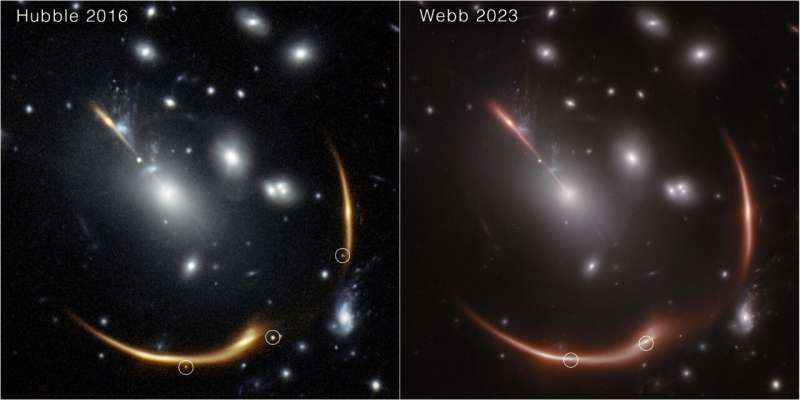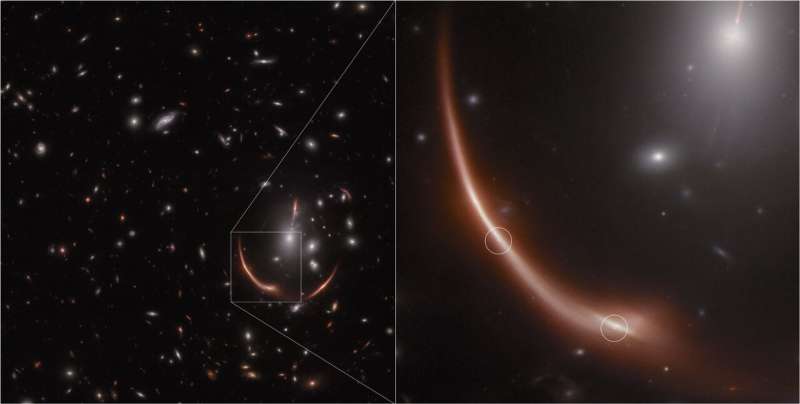NASA’s James Webb Space Telescope discovered a multiple-image supernova named MRG-M0138 in a distant galaxy. Two supernova images (circled) are visible in the Webb NIRCam (Near Infrared Camera) image above, but another supernova image is expected to be visible around 2035. In this image, blue represents light at 1.15 and 1.5 microns (F115W+F150), green is 2.0 and 2.77 microns (F200W+277W), and red is 3.56 and 4.44 microns (F356W+F444W). Image credit: NASA, ESA, CSA, STScI, Justin Pierel (STScI), and Andrew Newman (Carnegie Institution for Science).
In November 2023, the James Webb Space Telescope observed a giant galaxy cluster called MACS J0138.0-2155. Through the gravitational lensing effect first predicted by Albert Einstein, a distant galaxy named MRG-M0138 is distorted by the powerful gravity of the intervening galaxy cluster. In addition to distorting and magnifying the distant galaxy, the gravitational lensing effect caused by MACS J0138 produced five different images of MRG-M0138.
In 2019, astronomers announced the surprising discovery of a stellar explosion, or supernova, occurring inside MRG-M0138, as seen in images taken by NASA’s Hubble Space Telescope in 2016.
When another team of astronomers examined the 2023 Webb image, they were surprised to find a second supernova in the same galaxy seven years later. Justin Pierre (Einstein Fellow at NASA’s Space Telescope Science Institute) and Andrew Newman (Astronomer at the Carnegie Institution for Science) tell us more about the first-ever discovery of two gravitationally lensed supernovae in the same galaxy. Lots of information.
“When a supernova explodes behind a gravitational lens, its light takes several different paths to reach Earth. We can compare these paths to several trains leaving the station at the same time, all traveling at the same speed and heading to Same location. The trains travel different routes and don’t arrive at their destinations at the same time due to differences in trip length and terrain.”
“Similarly, astronomers see images of gravitationally lensed supernovae over the course of days, weeks, or even years. By measuring the differences in the timing of supernova images, we can measure the history of the universe’s expansion rate, known as the Hubble constant, which is today’s A major challenge in cosmology. The problem is that these multiplexed supernovae are extremely rare: fewer than a dozen have been detected so far.”

Left: In 2016, NASA’s Hubble Space Telescope discovered a multiplexed supernova, nicknamed “Supernova Requiem,” in a distant galaxy that was lensed by the intermediate galaxy cluster MACS J0138. Three images of the supernova are visible; a fourth image is expected to be released in 2035. In this near-infrared image, light at 1.05 microns is shown in blue and light at 1.60 microns is shown in orange. Right: In November 2023, NASA’s James Webb Space Telescope discovered a second multiple-imaging supernova in the same galaxy using the NIRCam (Near Infrared Camera) instrument. This is the first known system to produce multiple multiple-image supernovae. Download full resolution side-by-side images. Hubble image source: NASA, ESA, STScI, Steve A. Rodney (University of South Carolina) and Gabriel Brammer (Cosmic Dawn Center/Niels Bohr Institute/University of Copenhagen); JWST image source: NASA, ESA, CSA, STScI, Justin Pierel (STScI), and Andrew Newman (Carnegie Institution for Science).
“In this small club, the 2016 supernova in MRG-M0138, named Requiem, stands out for several reasons. First, it is 10 billion light-years away. Second, this supernova may be related to The same type (Ia) used as a supernova. The ‘standard candle’ for measuring cosmic distances.”
“Third, models predict that one of the supernova images, delayed by its path through the cluster’s extreme gravity, will not be visible to us until the mid-2030s. Unfortunately, Requiem was not discovered until 2019, It was not discovered until much later. When it disappeared from view, it was impossible to collect enough data to measure the Hubble constant.”
“Now we have discovered a second gravitationally lensed supernova in the same galaxy as Requiem, which we call supernova Encore. Encore was discovered by accident and we are now actively tracking it through a time-sensitive Director’s Discretionary Program Supernova going on.”
“Using these Webb images, we will measure and confirm the Hubble constant based on this multiple-image supernova. Encore was confirmed to be a standard candle supernova, or Type Ia supernova, making Encore and Requiem the most distant standard pair to date. Candlelight supernova ‘siblings’ ever discovered.”
“Supernovae are usually unpredictable, but in this case we know when and where we will see the final appearance of the Requiem and Encore. Infrared observations around 2035 will capture their final cheers and a new precise measurement of the Hubble constant.”
Provided by the Space Telescope Science Institute
citation: Webb discovers second lenticular supernova in distant galaxy (2023, December 21), Retrieved December 22, 2023 https://phys.org/news/2023-12-webb-lensed -supernova-distant-galaxy.html
This document is protected by copyright. No part may be reproduced without written permission except in the interests of fair dealing for private study or research purposes. Content is for reference only.
#Webb #discovers #lensed #supernova #distant #galaxy
Image Source : phys.org
